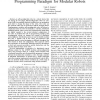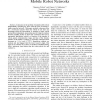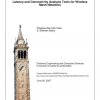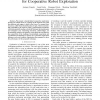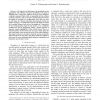ROBOCOMM
2007
IEEE
14 years 1 months ago
2007
IEEE
—A self-reconfigurable robot is a robotic device that can change its own shape. Self-reconfigurable robots are commonly built from multiple identical modules that can manipulat...
ROBOCOMM
2007
IEEE
14 years 1 months ago
2007
IEEE
—Modeling and simulation can be powerful tools for analyzing multi-agent systems, such as networked robotic systems and sensor networks. In this paper, it is shown concretely how...
ROBOCOMM
2007
IEEE
14 years 1 months ago
2007
IEEE
Abstract—This paper presents an information-theoretic approach to sensor placement that incorporates communication capacity into an optimal formulation. A new formulation is pres...
ROBOCOMM
2007
IEEE
14 years 1 months ago
2007
IEEE
—Coalescence is the problem of isolated mobile robots independently searching for peers with the goal of forming a single connected network. This paper analyzes coalescence time ...
ROBOCOMM
2007
IEEE
14 years 1 months ago
2007
IEEE
—The vision of network robot systems involves robots embedded in smart environments, with which they can collaborate and communicate. In such systems, robots have access to many ...
ROBOCOMM
2007
IEEE
14 years 1 months ago
2007
IEEE
ROBOCOMM
2007
IEEE
14 years 1 months ago
2007
IEEE
ROBOCOMM
2007
IEEE
14 years 1 months ago
2007
IEEE
— The integration of advanced computation, wireless communication, and control technologies has facilitated the creation of autonomous robot swarms for many civil and military ap...
ROBOCOMM
2007
IEEE
14 years 1 months ago
2007
IEEE
—The fields of autonomous robotics and ambient intelligence are converging toward the vision of smart robotic environments, in which tasks are performed via the cooperation of m...
ROBOCOMM
2007
IEEE
14 years 1 months ago
2007
IEEE
— The objective of this paper is decentralized swarm aggregation with collision avoidance. Specifically, each agent is assigned with a control law which is the sum of two elemen...
